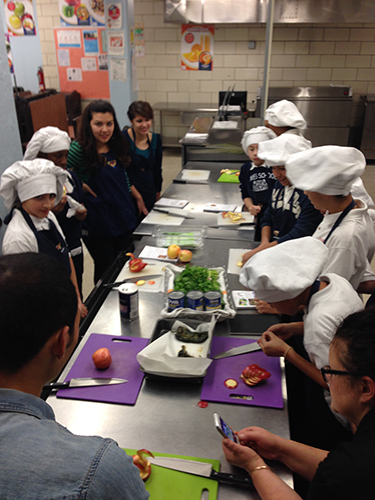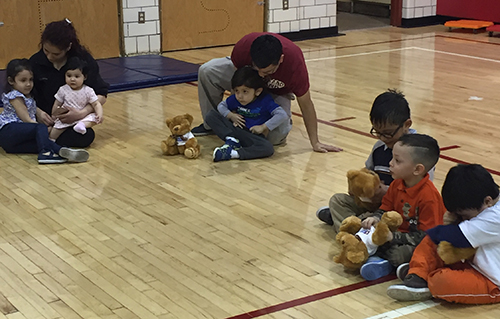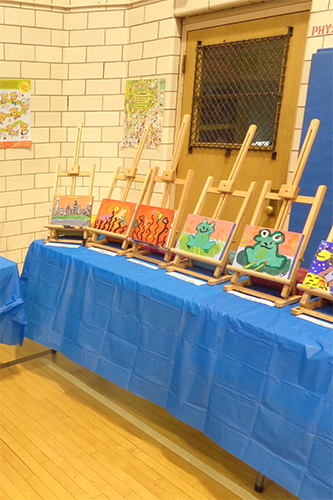Program Profile: Dawes Elementary
How do you develop thriving partnerships that benefit your 21st CCLC program, your school, and the community? Ask the team at the 21st CCLC site at Dawes Elementary School. Dawes is part of Chicago Public Schools' (CPS) Community Schools Initiative (CSI), which aims to bring together academic and social supports to ensure that all students succeed by offering the appropriate programming for students and their families before, during, and after school. By purposefully and actively involving local and significant stakeholders, the school and 21st CCLC program have helped create a culture of true community for students, their families, partners, and encompassing communities.
 |
| Students at a cooking class provided by Common Threads |
One of the principal partnerships is with Metropolitan Family Services, which has been at the forefront of the community school movement since it began in Chicago in 1996. Metropolitan employs full-time on-site resource coordinators at Dawes and at other community schools who administer the 21st CCLC programming and various partnerships. “Metropolitan Family Services also offers a full range of community services that the resource coordinators are able to access to provide referrals to the participants in our 21st CCLC programming and their families,” says Maria Nava, the resource coordinator at Dawes. “The strong partnership between Metropolitan Family Services and our school serves as the model and expectation for partnership with additional community organizations. These partnerships are grown both through resources received by Metropolitan Family Services as well as those received at Dawes School. The communication between the resource coordinator, other staff from Metropolitan Family Services, and Dawes School Principal Mary Dixon creates opportunities for the growth of new partnerships as well as the ability to maintain and expand existing partnerships within the community.”
Dawes has engaged with several other community partners and offers a range of activities. These include cooking and nutrition classes with the nonprofit organization Common Threads, hockey classes with representatives from the Chicago Blackhawks, and dancing activities with Dancing with Class. (A full list of community partners can be found on the Dawes website at http://www.dawes.cps.k12.il.us/community.html.) The Dawes team cites the school’s relationship with Dancing with Class as just one example of the program’s many flourishing partnerships. Dancing with Class started by offering afterschool programming to students in kindergarten through second grade. As a result of the high-quality afterschool programing and the school’s commitment to offering diverse learning experiences to students, Dancing with Class’s partnership with Dawes has grown beyond the 21st CCLC to also include provision of year-round programming during school for seventh- and eighth-grade students along with continuation of the afterschool programming. The relationship with Dancing with Class also illustrates how many partnerships can support both the school and the 21st CCLC program.
 | |
| Participants in the Healthy Families Toddler Class that is held in collaboration with Beacon Therapeutics. On Bear Givers Day, toddlers exchange stuffed bears as a symbol of their newly acquired social skills. |
The various partners also collaborate to host events for outside community members. In June, for example, Dawes will partner with Metropolitan Family Services and six other community schools in the area to host the second annual Summer Dash 5K. Organized by the resource coordinators and their supervisors and supported by school and community leaders, the race raises funds for summer programming and fosters awareness for the Community Schools Initiative. “[The race] is another example of how community engagement and collaboration between community partners can positively impact 21st CCLC programs,” says Nava.
 |
| Student artwork on display |
As a member of the Community Schools Initiative, some features of Dawes’ 21st CCLC and its partnerships are unique to the CSI model. There are, however, several strategies and lessons for any grantee who wants to increase community engagement. “A great part of our success with community partnerships is maintaining constant communication and setting aside time for community partners to meet and reflect on the programming offered to students,” says Nava. She notes that this includes a range of communication strategies, including face-to-face meetings. Many of the community partners are part of the Parent Advisory Council, the Bilingual Advisory Council, and other collaborative teams. The monthly meetings are “a built-in guarantee for communication since all stakeholders are present and able to have open discussions face to face,” says Nava. Dawes also has designated one person as the contact for the different community partners, which facilitates much simpler and effective communication, event coordination, and program planning. The strategy also strengthens existing relationships and makes it easier to establish new partnerships.
Both the school and the 21st CCLC program have reaped the benefits of strong community partnerships. “Community partnerships and community engagement support 21st CCLC programming by providing resources for sustainability and fostering awareness of the community school model,” says Nava. “Ongoing partnerships with other community organizations help to support the quality programming offered, and expand that programming based on the school needs. Our partners are invested in our school, and their investment is shown through their commitment to our students.”
